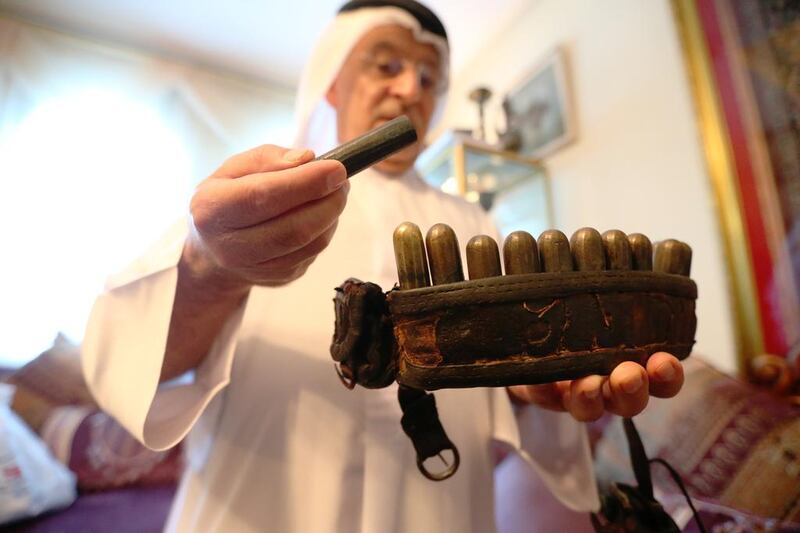James Langton
Amid the display cases of glittering gold bracelets, imposing khanjar knives and magnificent silver bridal headpieces, Dr Ahmed Khoori singles out a simple leather belt packed with tarnished brass cylinders as one of items in his collection that he is most proud off.
“This is very, very old,” he says. “From maybe the 1830s. It would give you fast loading for a flintlock rifle.”
The brass containers – 12 in total – were ready-packed with shot and exactly the right amount of powder, either for hunting, or more likely, fighting.
Its original owner would have been a Bedouin, wandering the desert of what is now the Northern Emirates or the interior of Oman, at a time when national boundaries meant nothing but tribal loyalties were everything.
By having his shot ready-prepared for the muzzle-loaded rifle, the belt’s owner could win a few precious seconds on his enemies and live to fight another day.
Another clue to Bedu life two centuries ago comes in a small pouch attached to the still-supple goat leather. It contains a flint to be struck on a small hook of ridged brass also on the belt. In this way the tribesman would make fire.
“I am told the gunpowder may be still inside,” says Dr Khoori. “But I’m not going to check.”
Packed inside his villa just off Abu Dhabi’s Corniche is one of the most astonishing collections of historic artefacts from the Arabian Gulf.
The boxes flow out into the garden, where there is also a splendid carved teak door originally from India. It comes from his family’s old home, now long demolished, which once stood in the original Abu Dhabi souq, where the new Central Market stands.
Since items from his collection were last featured in The National for the 40th anniversary of the UAE in 2011, Dr Khoori has been concentrating on finding objects from the Arabian Gulf. Now he is keen to show off his new acquisitions.
Among them are several examples of the khanjar – the knife with a curved scabbard that symbolises manhood in the region. One of them is elaborately chased in silver and gold, to be worn by a wealthy merchant or sheikh on important occasions.
But Dr Khoori is more interested in some simpler khanjar, with scabbards of plain leather. The blades, though, are sturdy, sharp, practical and hint at death.
“Look at the thickness of the blade,” he says. “This is for combat.”
Another khanjar, with a handle of giraffe horn, has more elaborate silver decoration on the leather but still has a blade that means business.
“This is similar to one Sheikh Zayed would have used,” explains Dr Khoori. “It is a simpler one because he was half-Bedouin.”
The more elaborate khanjar is decorated with silver rings, to represent the status of the owner. This one has seven rings – the most Dr Khoori has seen before is five. Clearly, the owner was someone special.
Other new items from the collection are more elaborate. A breathtaking bridal headpiece is covered with about 100 tiny gold cones.
Made in the early 20th century, it is an example of local craftsmanship that includes leather braids and two finely worked gold discs to sit over the forehead.
“It must be at least 90 years old,” Dr Khoori says. “They didn’t make anything like this after the 1950s.”
Next he sets down two heavy silver bracelets, designed to be worn by local women. One set is decorated in rounded cones, in the other they are more pointed. Delicately, Dr Khoori explains that the rounded version is for older women, the other represents young girls.
By contrast are two smaller bracelets of gold overlaid on silver. There is nothing quite like them in the collection, although Dr Khoori says he has no explanation for their flattened shape.
Like all the items in the collection, they have been viewed only by a privileged few.
Dr Khoori, who will shortly retire from the Abu Dhabi Company for Onshore Oil Operations, now hopes to find the finances for a private museum that will display them to a wider audience.
“There is nothing like this” he says. “This is the culture of the Gulf.”






